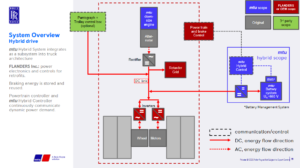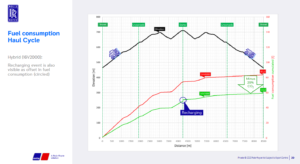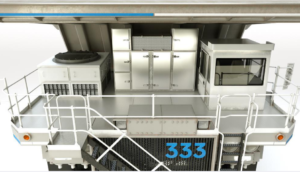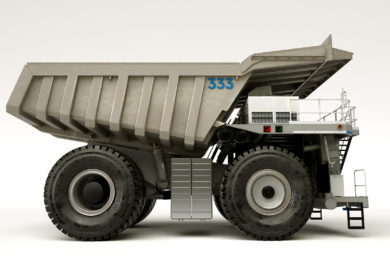Diesel engines remain the ideal prime mover for mining trucks. They are the benchmark for performance, availability, maintainability, refuelling range, costs, and are suitable for extreme environmental conditions. But they also account for about 50% of the GHG emissions of a typical mining operation. Reducing these emissions is a major lever for mining companies to achieve their ambitious decarbonisation goals.
With their typical operating cycle — hauling loads uphill and returning to the loading position usually the same way downhill — mining trucks provide the opportunity to recuperate a considerable amount of energy downhill and store it in batteries. Depending on the topographic profile of the individual mine, up to 30% diesel fuel savings, respectively GHG reductions, are possible.

Rolls-Royce is already offering mtu engines that fulfil the strict Tier 4 emissions standard to the mining industry, and with not aftertreatment which is unique in the market. These engines not only bring down fuel consumption – and thus CO2 emissions – by around 6% compared to Tier 2 engines, but also cut NOx emissions by 45% and particulate matter by 80%. At the same time they offer increased power with no power loss at altitudes of up to 5,500 m (18,000 ft) as well as reduced installation, maintenance and total ownership costs.
But battery-hybrid powertrains are also a key milestone toward fully GHG-neutral mining truck propulsion, as they help to diminish the drawbacks of potential GHG-neutral fuels: scarcity, costs and/or limited energy storage density. In a recent presentation by Rolls-Royce Application Engineer Alexander Richter, who also is the technical Product Manager for its Series 2000 engines, the company presented the concept of a hybrid drive system for mining trucks, which it will also highlight at MINExpo in September.
A key point about the solution is that it is based on existing and proven mtu technologies. Richter said that Rolls-Royce envisions equipping mining trucks with battery packs (so-called mtu EnergyPacks), allowing for significant CO2 emissions reductions, less noise and cost savings for the customer at the same time. The batteries are in series production for hybrid trains which will soon enter service, first in the UK.

The mtu EnergyPack is SIL 2 certified for rail passenger transportation and uses lithium–ion technology plus is liquid cooled/heated. They have 30.6 kWh capacity, 75 kW continuous power and 660V nominal voltage. They weigh about 370 kg with 1,600 mm x 750 mm x 220 mm dimensions. mtu DC/DC converters are integrated into the inverter cabinet plus the hybrid system is modular & scalable. The battery state of charge (SoC) is about 130 kWh, ie 22% of total capacity which is good for battery service life. Looking at CO2 savings, simulations for a 220 t truck used assumptions of cycle time 30 min; travel: 22 min plus queue, load, dump 8 min, so two cycles/h. This equates to 165 l/h and 2.65 kg CO2/l diesel fuel: total 6,500 h/year and 100,000 h truck life. Savings are 30% CO2 savings for a factory installed hybrid and 22% CO2 savings for a retrofit. The overall weight is higher with the hybrid – while 6 t are removed with the smaller engine and 2 t from the smaller tank, the batteries add 7.4 t and the DC/DC converters add 2 t.

For the 220 t truck, there would be 20 x EnergyPacks and 10 x DC/DC converters. There is a downsized engine – now using an mtu 16V 2000 S96, so 3,600 kg vs 9,500 kg and 36 l vs 60 l; 1,163 kW vs 1,865 kW (1560 hp vs. 2500 hp) and Tier 4i vs Tier 2 with fuel efficiency optimised operation strategy. Plus obviously there is a reduced tank size. The 20 x EnergyPacks replace the original diesel tank so the downsized diesel tank can be moved to the opposite side (this is one of many options, to be agreed with customers).
The batteries are recharged by recuperating braking energy when going downhill. This stored energy is used to provide power to the mining truck when going uphill loaded, which leads to fuel savings and allows for the downsizing of the truck’s engine. The solution is based on proven components, an it is planned as a retrofit offering for existing and also being available on newbuilt trucks and will be realised in partnership with customers. The mtu Hybrid System integrates as a subsystem into the truck architecture, plus FLANDERS Inc power electronics and controls can be utilised for retrofits. The powertrain controller and mtu Hybrid Controller continuously communicate dynamic power demand.

Richter also said that in the not so distant future, two more technologies pioneered by Rolls-Royce may help mining operations become green and reach net zero carbon emissions: mtu engines are currently being prepared to run on sustainable fuels which are made from hydrogen with the help of renewable power. These fuels play a key role in reducing greenhouse gas emissions in applications which are hard to electrify. By 2023, the newest generations of mtu Series 2000 and 4000 engines are set to be compatible with these fuels.
Hydrogen also plays a salient role in another future technology Rolls-Royce is currently working on: Fuel cells will soon be part of the company’s portfolio – first in stationary applications (power generation) but possibly for mining as well at a later stage.










